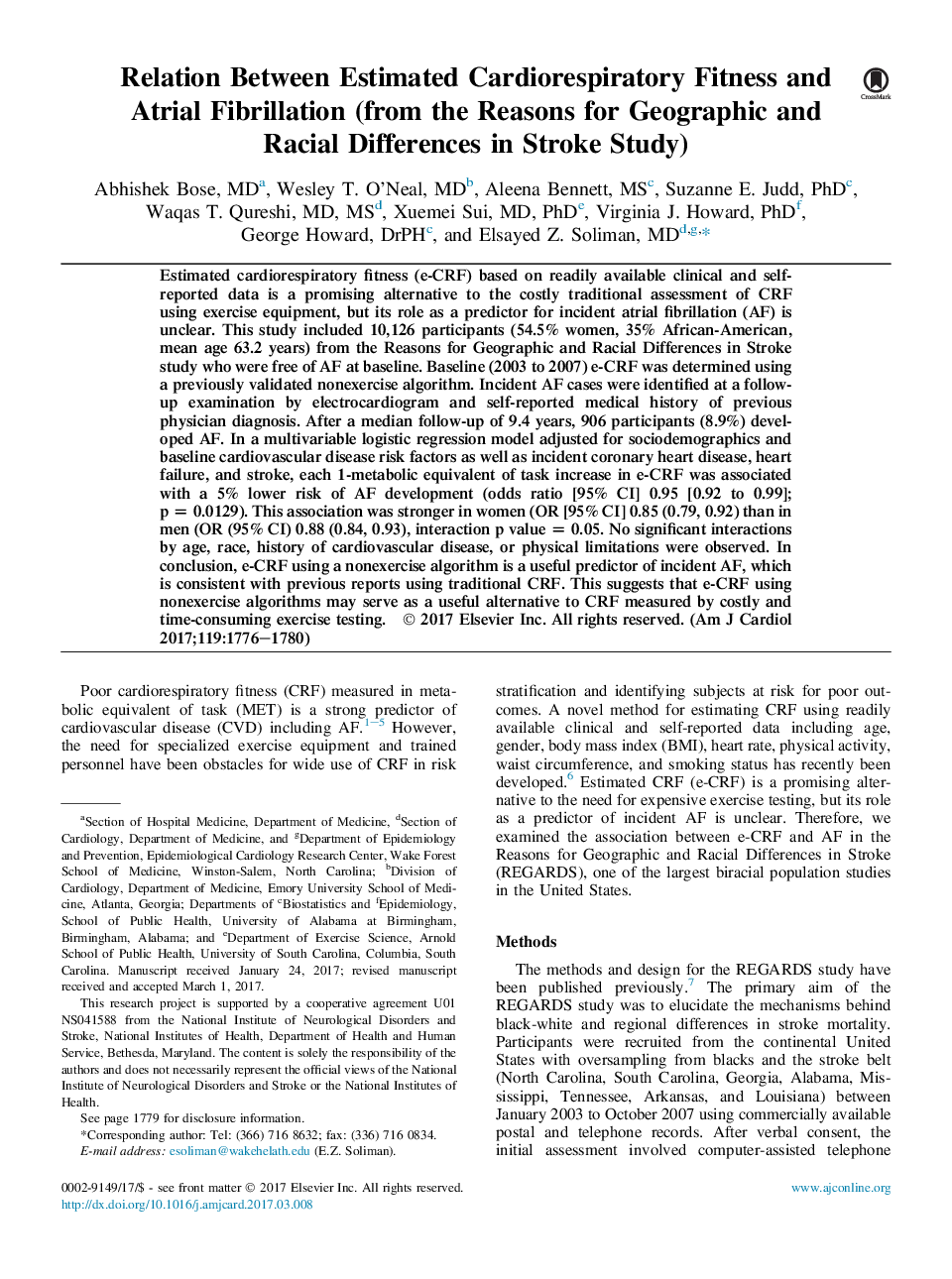| کد مقاله | کد نشریه | سال انتشار | مقاله انگلیسی | نسخه تمام متن |
|---|---|---|---|---|
| 5594901 | 1572086 | 2017 | 5 صفحه PDF | دانلود رایگان |
عنوان انگلیسی مقاله ISI
Relation Between Estimated Cardiorespiratory Fitness and Atrial Fibrillation (from the Reasons for Geographic and Racial Differences in Stroke Study)
ترجمه فارسی عنوان
رابطه بین ارزیابی آمادگی جسمانی و فیبریلاسیون دهلیزی (از دلایل تفاوت های جغرافیایی و نژادی در مطالعه سکته مغزی)
دانلود مقاله + سفارش ترجمه
دانلود مقاله ISI انگلیسی
رایگان برای ایرانیان
موضوعات مرتبط
علوم پزشکی و سلامت
پزشکی و دندانپزشکی
کاردیولوژی و پزشکی قلب و عروق
چکیده انگلیسی
Estimated cardiorespiratory fitness (e-CRF) based on readily available clinical and self-reported data is a promising alternative to the costly traditional assessment of CRF using exercise equipment, but its role as a predictor for incident atrial fibrillation (AF) is unclear. This study included 10,126 participants (54.5% women, 35% African-American, mean age 63.2 years) from the Reasons for Geographic and Racial Differences in Stroke study who were free of AF at baseline. Baseline (2003 to 2007) e-CRF was determined using a previously validated nonexercise algorithm. Incident AF cases were identified at a follow-up examination by electrocardiogram and self-reported medical history of previous physician diagnosis. After a median follow-up of 9.4 years, 906 participants (8.9%) developed AF. In a multivariable logistic regression model adjusted for sociodemographics and baseline cardiovascular disease risk factors as well as incident coronary heart disease, heart failure, and stroke, each 1-metabolic equivalent of task increase in e-CRF was associated with a 5% lower risk of AF development (odds ratio [95% CI] 0.95 [0.92 to 0.99]; p = 0.0129). This association was stronger in women (OR [95% CI] 0.85 (0.79, 0.92) than in men (OR (95% CI) 0.88 (0.84, 0.93), interaction p value = 0.05. No significant interactions by age, race, history of cardiovascular disease, or physical limitations were observed. In conclusion, e-CRF using a nonexercise algorithm is a useful predictor of incident AF, which is consistent with previous reports using traditional CRF. This suggests that e-CRF using nonexercise algorithms may serve as a useful alternative to CRF measured by costly and time-consuming exercise testing.
ناشر
Database: Elsevier - ScienceDirect (ساینس دایرکت)
Journal: The American Journal of Cardiology - Volume 119, Issue 11, 1 June 2017, Pages 1776-1780
Journal: The American Journal of Cardiology - Volume 119, Issue 11, 1 June 2017, Pages 1776-1780
نویسندگان
Abhishek MD, Wesley T. MD, Aleena MS, Suzanne E. PhD, Waqas T. MD, MS, Xuemei MD, PhD, Virginia J. PhD, George DrPH, Elsayed Z. MD,
